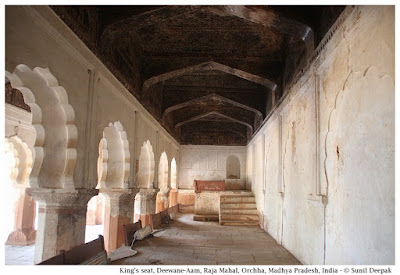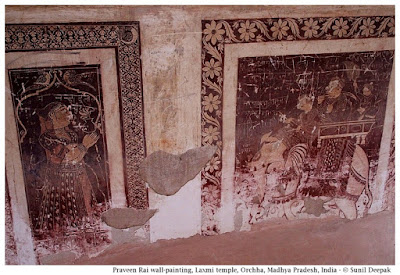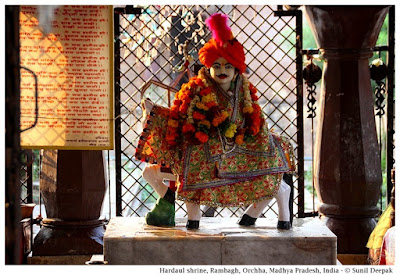In the 16th century India, the Bundela kings chose Orchha as their capital. Its days of glory lasted till about the end of the 17th century. The surviving buildings from that period are among the most beautiful examples of Bundela architecture.
You can read more about the
Bundelkhand region in one of my earlier blog-posts. This post is about the temples, cenotaphs (
chhattris) and some other buildings of Orchha.
General information about Orchha
Orchha is a tiny sleepy town in northern Madhya Pradesh (MP), close to its border with Uttar Pradesh (UP). The nearest railway station is in
Jhansi in UP, around 20 km away, from where you can easily get an auto or a car to reach Orchha. There is a local train station in Orchha but it is a bit away from the city and trains are infrequent.
Orchha is located along the
Betwa river. The river's old name was Vetravati. In "Padma Purana" it was called the Ganges of Kaliyuga. Ancient sages Parashar and Bhrigu had their ashrams along its bank. Near Orchha, the river divides into different streams that create a big island in its middle, which hosts the Tangaranya forest. A narrow bridge (image below) that can be submerged during the monsoons, connects the island to the Orchha town.
The region around Orchha is full of old medieval towns with the ruins of medieval temples, forts and lakes. Unfortunately this area is not easily accessible for tourists. Except for a private taxi, the public transport options are extremely limited in the area.
The places described in this post are all located in a relatively small area of Orchha close to the river and can be easily visited on foot.
A Brief history of Orchha
It became the capital of Bundela king
Rudra Pratap in 1530. He died soon after shifting here and was succeeded by Bharati Chandra (1531-54), and then, Madhukar Shah (1554-92). This last period coincided with the establishment of Mughal empire in India.
Bundelas had a tumultuous relationship with the Mughals. They lost wars to them, swore allegiance and then, whenever they got the chance, rebelled and fought for independence. Thus, the Mughals could never take them for granted. Mughal emperor Akbar's army attacked and defeated
Madhukar Shah in 1577. He joined Akbar's court but later, continued to fight, eventually winning back some of the lost areas.
His son Rama Shah made peace with Akbar and joined his court. While he stayed in emperor's court, Orchha was looked after by his younger brother Indrajit Singh. They had another brother,
Bir Singh who became an ally of prince Salim. After Akbar's death in 1605, Salim became emperor Jahangir (1605-27), and he made Bir Singh the king of Orchha (1606-27).
Bir Singh's reign is called the golden period of Orchha. He built different forts, temples and water-tanks in Bundelkhand, including the Jhansi fort. (In the image below the cenotaphs of Bir Singh and of his military commander, Kripa Ram Gaur)
After the arrival of
Shah Jahan on the Mughal throne in 1627, fighting between the Bundelas and the Mughals restarted. Bir Singh's son King
Jujhar Singh was forced to take refuge in a forest and was killed in 1635. His younger brother Pahad Singh, who had sided with the Mughals, was made the ruler of Orchha in 1642. Slowly over most of the 17-18th centuries Orchha kingdom declined.
Parts of this history are not clear. For example, Shah Jahan's biography says that in 1635, he had sent his son Aurangzeb to destroy the temple of the Orchha king. By that time, Orchha had at least three big temples - Raja Ram temple, Chatturbhuj temple and Laxmi Narayan temple. However, in Orchha, I could not find any story about a temple destruction. Perhaps, Shah Jahan's order referred to the destruction of Keshav Dev temple in Mathura, which was also built by Bir Singh Deo and was destroyed by Auranjzeb?
The image below shows some of the cenotaphs Orchha built close to Betwa river.
The Vaishnav poet
Keshavdasa, who wrote
Rasikpriya about the love of Krishna and Radha, lived in Orchha during the final years of Madhukar Shah and during the reign of Bir Singh. He also wrote
Birsimhadeva Charita and
Jahangir Jas Chandrika in the praise of Bir Singh and his patron Jahangir. The poet's house in Orchha is now used a school.
Orchha Fort
The fort's construction was started under the first king Rudra Pratap and after his death, completed by his son Bharati Chandra. Their successors added other buildings to the original fort, especially Bir Singh Deo, who built "Jahangir Mahal" in the fort. The image below shows the fort walls and Raja Mahal built under Madhukar Shah.
The fort is located on an island close to Betwa. A 105 metres long bridge (
Terah Dwari) built under the reign of Bir Singh links the fort to the town. (In the image below, the bridge and the town seen from the fort)
It is a beautiful fort. I will write a separate post about it, so I won't go in details about it here.
Chatturbhuj temple
Bundelas were Vaishnav, followers of Krishna. However, Ganesh Kunwar, wife of Madhukar Shah, was a follower of Rama. Chatturbhuj was the first major temple of Orchha, built for her in mid 16th century. She went to Ayodhaya to get the lord Rama statue for this temple. However, it could not be installed in Chatturbhuj because of a war with the Mughals and the death of prince Hardaul. Therefore, it was decided to keep the statue in the Queen's palace.
However, there is a legend that tells a different story about the missing Rama statue from the Chatturbhuj temple. The legend says that the queen dreamed that the statue of Rama, once taken from Ayodhaya, must not be put on ground till it reached the place of its installation. However, when she brought the statue to Orchha, Chatturbhuj temple was not yet ready, so the statue was kept in her palace next door. Once the temple was ready, they found that the statue had become fixed to the ground in the palace and could not be moved. Thus, the beautiful Chatturbhuj temple remained without its deity while the queen was forced to convert her palace into a temple.

The Chatturbhuj temple is built on a raised stone platform. The temple has a 3-storied building, with steps to go up to the ground floor. It is the tallest building in Orchha. After the entrance, the temple has an open area which leads to a rectangular building known as Mahamandap. A corridor from Mahamandap leads to Garbhgriha (the womb or the most sacred room).
Ram Raja temple
This old royal palace of Madhukar Shah's queen, converted into a temple, is the most important religious building in Orchha. It is an important pilgrimage centre for Bundelkhand region. It has an outer wall with a gate that leads to a vast open area.
Inside there is another high fortified wall and a second gate with a palanquin arch at the top. Behind the entrance, there is a screen-wall, before you reach the temple. Inside the temple complex, there are residential apartments arranged in three tiers. Painted in shades of yellow and orange, it is surrounded by a market.
Raja Ram temple's structure is clearly that of a palace. However, its architecture is completely different from all the other buildings of Orchha, perhaps because of its yellow and orange paint.
Phool bagh and the Hardaul temple
Phool Bagh gardens were built near the Raja Ram temple by king Bir Singh Deo in 1611 to welcome emperor Jahangir when he came to Orchha for king's coronation. It is said that the garden included a huge stone cup full of wine for the emperor's welcome ceremony.
Water channels and pathways divided this garden into four parts (char bagh), with a fountain at the centre. Each part had eleven octagonal areas for the flower beds. Thus it was clearly influenced by Mughal architecture including the use of water for beauty and cooling.
Later the temple of Hardaul, younger son of Bir Singh Deo, was built in the centre of Rambagh and today it is better known as Hardaul Vatika. Prince Hardaul was poisoned by his elder brother king Jujhar Singh, who suspected that his wife had an illicit relationship with his brother. Hardaul was loved by people, who believed that he was innocent. Thus, the Hardaul temple was built by the people, who tie threads on its
jaali (wire net) asking for divine help.
Other palaces and buildings near Raja Ram temple
There are many other buildings in this area including the palace of Jujhar Singh and a pair of towers known as
Sawan-Bhadon, which were used for facilitating the circulation of air in an underground hall, to the side of Raja Ram temple.
The towers are supposed to have open vents at the top. This way of using towers to create air-current was supposedly imported from Persia. However, I could not find any archaeological document detailing the underground hall and the way the 2 towers fitted into it.
Another local story considers the two towers to be the memorials of Prince Baghraj (son of Bir Singh Deo) and Mahatma Anupgiri.
Laxmi temple
This temple is built on a hill by the side of a lake, a little away from the Orchha fort and the city centre. It was built under the reign of Bir Singh Deo. Externally, it is rectangular in shape with a multi-foliated projecting bastion at each corner. With holes for canons in its outer wall, it looks like a fort.
The entrance leads to an open area with covered corridors (
Parikrama) on the four sides. The temple is full of beautiful wall-paintings, showing sacred themes as well as, historical scenes. I was really fascinated with these wall-paintings. I hope to write a separate post about them. In the mean time, here you can see two examples - one showing a scene from Ramayana and the other showing two Europeans (one with a gun and the other, with a glass of wine).
The
garbhgriha (main sacred room) is in the centre in an octagonal space placed at the tip of triangle-shaped building. It is said that it once had a gold statue of Laxmi. Its special architecture with external rectangle, and an inner triangular temple with octagonal dome, make it a special building for the Indian
Vaastu Shastra.
At the top, the corners of the dome are decorated with conical stones that look like curved lotus petals. Its shikhara (pinnacle) is different from other Bundela pinnacles, as it includes birds and a circular wheel (symbolising Vishnu).
At the top of the temple, the different domes and palanquin arches, so characteristic of the Bundela architectural style, are connected by the ramparts from where you can have beautiful views of the surroundings. When I visited it, I could not see the lake mentioned in the guide book - perhaps it was dry.
Chhattris (Cenotaphs)
Before the arrival of Turks in India, there was no tradition of building cenotaphs among the Hindu kings. The Muslim custom of building tombs for the dead emperors influenced Rajputs, who started building Chhattris (cenotaphs) to commemorate the memories of specific kings. Orchha has some of the most beautiful Rajput
chhattris in India to commemorate its Bundela kings.
The chhattris were built along the bank of Betwa river. The cenotaph of each deceased king was built by his successor.They were usually built over the stones (samadhi), where the bodies of the deceased kings were cremated. They usually have halls with columns and multiple openings on the sides.
There is a group of 9 cenotaphs of Bundela kings in Orchha, subidivided in two parts - the first group has 3 (of Bharati Chandra, Madhukar Sah and Pahad Singh); the second group has 5 (Jaswant Singh, Bhagwant Singh, Sanwant Singh, Indramani Singh and Sujaan Singh). The second group is set in a char-bagh kind of garden.
An additional cenotaph, that of king Bir Singh Dev, is separate from all others, built on a promontory close to Betwa river, and is the biggest building. It was built by his son Jujhar Singh in 1627-28.
The last cenotaph built in Orchha was of Sanwant Singh built by his son Het Singh in 1765. It is a small but beautiful building, showing that though the power and prestige of Bundela kings had diminished during 17th century, they continued to be in Orchha till late 18th century.
Apart from the royal cenotaphs, there are some other cenotaphs in the area. For example, in front of Bir Singh Dev's
chhattri is the small but beautiful
chhattri of Kirpa Ram Gaur, his military commander.
Orchha does not have any cenotaphs for the Bundela queens, as found in some other places of Bundelkhand, such as the cenotaph of queen Kamalapat in Chhattarpur.
Sundar Shah Mahal
This building is from the 17th century. The legend says that Sundar Shah, the love child of king Indramani and princess Mehrunissa, daughter of Mughal emperor Aurangzeb, lived here. Later, two sufi saints, Syed pir and Zahar pir also lived here and their shrines were built inside. At present, it is seen as a religious place for the followers of the two pirs.
Narayan Das Khare ki Kothi
Ruins of this old house are located near the Laxmi temple. I didn't go to see it, just saw it from a distance. It has a three-storied entrance gate which is visible from afar. On the top floor, the arched windows are surmounted by a semi-circular roof (a style called palanquin). The haveli was built in the 17th century. The house belonged to Narayan Das Khare who was a
lekhpal (record keeper) or
Deewan (revenue minister) of the Orchha kings.
Kirparam Gaur ki Haveli
As mentioned above, Kirpa Ram was a
senapati (military commander) of Birsingh Deo. Orchha poet Keshav Das wrote about the his bravery. Only the entrance gate of this haveli remains.
Wild Animals and birds in Orchha
The Tangaranya forest on the island in Betwa river, is a protected natural area. However, even the city provides different opportunities for nature lovers.
For example, Orchha hosts different species of vultures. Unfortunately, vultures have virtually disappeared from India, exterminated by the wide-spread use of an anti-inflammatory drug in the cattle. Thus I was thrilled when I saw the vultures around the cenotaphs. The image below shows a white-backed vulture.
Inside the Orchha fort I came across a large number of Hanuman langoor monkeys. Their antics and group and family behaviours were endlessly fascinating.
Underneath the Terah Dwari bridge leading to the fort, there were many egrets, lapwigs and herons. The image below has one heron (I am not sure if it is a striated heron or a green heron).
The city also seemed full of noisy parrots.
Conclusions
I think that in terms of its colours and architecture, along with the rugged rocky terrain, hills and the wild looking Betwa river, Orchha is one of the most beautiful places in India.
I was suprised that it had so few visitors. Let me conclude this travel-diary with a picture of the magnificent
chhattris of the Bundela kings along the Betwa river seen at sunset.
As I think of Orchha, I think of the Bundela queen Ganesh Kunwar and her statue of lord Rama that she kept in her palace. I also think of the poisoning of prince Hardaul by his suspicious elder brother king Jujhar Singh. So many events and so many stories are hidden under the layers of history. The ruins, if they could speak, would have so much to tell us. All the legends mentioned here have different versions, thus you can find other stories about them. For example, many persons do not agree with the story about the illicit relationship between queen Ganesh Kunwar and her brother-in-law. If you want to know more about these stories, you can read
my post about legends of Orchha.
***





































































